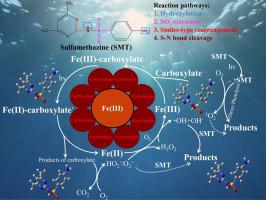Chemical Engineering Journal ( IF 15.1 ) Pub Date : 2020-07-02 , DOI: 10.1016/j.cej.2020.126122 Zhuozhi Ouyang , Chen Yang , Junheng He , Qian Yao , Bijie Zhang , Hanming Wang , Yu Jiang , Jini Zhou , Yurong Deng , Yanjun Liu , Jingjing Yang , Guining Lu , Zhi Dang

|
Sulfamethazine (SMT), taken as model compound, have been exposed to a photocatalytic system driven by ultraviolet light (UV) irradiation with Fe(III) and three carboxylic acids (citric, tartaric and malic acid). The kinetic experiments, quenching experiments, electron paramagnetic resonance (EPR), species model theoretical calculation, density functional theory (DFT) and intermediates analyses, were conducted to analyze the formation of reactive oxygen species (ROS) and underlying mechanism of Fe(III)-carboxylate complexes on photocatalytic degradation of SMT. The results indicated the complexes easily induced the degradation under UV irradiation. Enough hydroxyl radicals (·OH) were produced and the singlet oxygen (1O2) originated from the self-sensitized oxidation. An interaction among ROS, Fe(III)-carboxylate complexes and SMT was firstly proposed. The active sites and groups were characterized through Frontier electron densities (FEDs), Fourier Transform-Infrared (FTIR) and Two-dimensional correlation FTIR spectroscopy (2D-FTIR-CoS) analyses. The transformation pathway mainly included four reactions: hydroxylation, SO2 extrusion, Smiles-type rearrangement and S-N bond cleavage. The system also had an application potential for removing SMT from practical water.
中文翻译:

Fe(III)-羧酸盐配合物诱导的均相光催化降解磺胺二甲嘧啶的动力学,机理和产物
作为模型化合物的磺胺二甲嘧啶(SMT)已暴露于由Fe(III)和三种羧酸(柠檬酸,酒石酸和苹果酸)通过紫外线(UV)照射驱动的光催化系统。进行了动力学实验,淬灭实验,电子顺磁共振(EPR),物种模型理论计算,密度泛函理论(DFT)和中间体分析,以分析活性氧(ROS)的形成以及Fe(III)的潜在机理。 -羧酸盐配合物对SMT的光催化降解。结果表明该配合物在紫外线照射下容易诱导降解。产生足够的羟基自由基(· OH)和单线态氧(1 O 2)源自自敏氧化。首次提出了ROS,Fe(III)-羧酸盐配合物与SMT之间的相互作用。通过前沿电子密度(FED),傅立叶变换红外(FTIR)和二维相关FTIR光谱(2D-FTIR-CoS)分析来表征活性位点和基团。转化途径主要包括四个反应:羟基化,SO 2挤出,Smiles型重排和SN键断裂。该系统还具有从实际水中去除SMT的应用潜力。



























 京公网安备 11010802027423号
京公网安备 11010802027423号